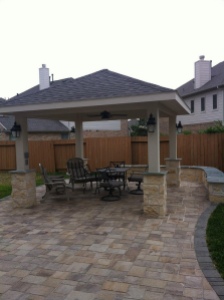Slate is an eye-catching and strong stone flooring. It’s easy to maintain and comes in a range of earth tones from grey to terra cotta. Installing a slate floor will require a level surface, with an underlayer of compacted sand and/or gravel. Slate’s natural texture can become slick when wet.

Slate
Flagstone is a natural sandstone composed of feldspar and quartz, which is durable and readily available in several earthy shades. Flagstones are quarried in all different shapes, lending a truly unique look to your outdoor lounge. Installation is comparable to putting together a giant puzzle over a base layer (we use a concrete base so the flagstones don’t shift), and requires removal of grass and existing pavement. Plus, depending on the size and shape of the stone, the pieces can be very heavy and difficult to work with.
Because it is a layered sedimentary rock, flagstone should be adequately sealed – and occasionally resealed – to fend off peeling and deterioration of the surface layers from sunlight and rain.

Stamped concrete patio with flagstone around the tree
Pavers are manufactured from a number of different stones (like sandstone, granite, blue-stone, limestone, and slate) or robust materials like concrete, brick, or even interlocking rubber panels. Pavers can replicate the look of natural stone, with a lower price tag and greater number of aesthetic options. Pavers are popular for their durability, low maintenance, and ease in repair/replacement. A bonus is that they can be removed and re-installed.

Belgard pavers
Brick gives your outdoor room a traditional, old-world beauty. Installation is relatively simple – as long as the ground underneath is level and the gravel (or other base layer) is properly compacted before laying the brick.
Brick flooring is relatively low-maintenance, although be attuned to the ground shifting over time, as your brick floor could become an irregular surface.

Brick
Wood decking offers easy installation, but the wood itself requires a thorough cleaning and resealing every couple years to maintain its beauty. Douglas fir has been highlighted as a particularly sound choice of species for its stability and lack of knots. Another popular wood, Ipe is a Brazilian hardwood known for its beauty and durability. Using a local hardwood like Texas red oak can make the project more economical.

Brazilian hardwood decking
Composite decking is great if you like the look of wood, but want to cut down on maintenance. Composite decking materials mimic the look of natural wood. This combination of wood and plastic does not absorb as much water – which helps keep the material strong (but can trap moisture and cause decay to the wood joists underneath). Composite decking can be more expensive than natural wood and cannot be resurfaced when scratched.